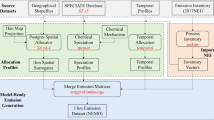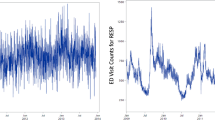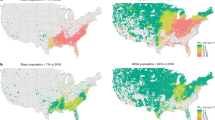Abstract
Air pollution prediction modeling establishes relationships between measurements and geographical and meteorological characteristics to infer concentrations at locations without measurements. Since air pollution monitors are limited in number, predictions may be generated for locations different than those used to train the model. The epidemiologic impacts of this potential mismatch hinge on whether the population resides in areas well-represented by monitoring sites. Here we quantify the fraction of the population with geographical characteristics not reflected by the 2000, 2010, and 2020 EPA PM2.5 and PM10 regulatory sites. We evaluated this measure nationwide, regionally, and by race. Nationally, the networks were very representative of the population experience; however, there was less overlap regionally and in regions stratified by race. This suggests that sub-national exposure modeling should carefully consider the representativeness of monitors for their populations. It also highlights that exposure models often borrow information from distal places to predict full population exposure.
This is a preview of subscription content, access via your institution
Access options
Subscribe to this journal
Receive 6 print issues and online access
$259.00 per year
only $43.17 per issue
Buy this article
- Purchase on Springer Link
- Instant access to full article PDF
Prices may be subject to local taxes which are calculated during checkout

Similar content being viewed by others
Data availability
The data that supports the findings of this study and the code to replicate all results in this study are available from the corresponding author (MP) upon reasonable request.
References
Di Q, Kloog I, Koutrakis P, Lyapustin A, Wang Y, Schwartz J. Assessing PM2.5 exposures with high spatiotemporal resolution across the continental United States. Environ Sci Technol. 2016;50:4712–21.
Kim SY, Olives C, Sheppard L, Sampson PD, Larson TV, Keller JP, et al. Historical prediction modeling approach for estimating long-term concentrations of PM2.5 in cohort studies before the 1999 implementation of widespread monitoring. Environ Health Perspect. 2017;125:38–46.
van Donkelaar A, Hammer MS, Bindle L, Brauer M, Brook JR, Garay MJ, et al. Monthly global estimates of fine particulate matter and their uncertainty. Environ Sci Technol. 2021;55:15287–300.
Yanosky JD, Paciorek CJ, Laden F, Hart JE, Puett RC, Liao D, et al. Spatio-temporal modeling of particulate air pollution in the conterminous United States using geographic and meteorological predictors. Environ Health. 2014;13:63.
Title 40 – Protection of Environment. Chapter I – ENVIRONMENTAL PROTECTION AGENCY Subchapter C – AIR PROGRAMS Part 58 – AMBIENT AIR QUALITY SURVEILLANCE. Appendix D to Part 58 – Network Design Criteria for Ambient Air Quality Monitoring.
US EPA, 2007. Ambient Air Monitoring Network Assessment Guidance: Analytical Techniques for Technical Assessments of Ambient Air Monitoring Networks. Publication No. EPA-454/D-07-001.
US EPA, 2019. Integrated Science Assessment for Particulate Matter. Publication No. EPA/600/R-19/188.
Szpiro AA, Paciorek CJ. Measurement error in two-stage analyses, with application to air pollution epidemiology. Environmetrics. 2013;24:501–17.
deSouza P, Kinney PL. On the distribution of low-cost PM2.5 sensors in the US: demographic and air quality associations. J Expo Sci Environ Epidemiol. 2021;31:514–24.
Keller JP, Olives C, Kim SY, Sheppard L, Sampson PD, Szpiro AA, et al. A unified spatiotemporal modeling approach for predicting concentrations of multiple air pollutants in the multi-ethnic study of atherosclerosis and air pollution. Environ Health Perspect. 2015;123:301–9.
Yanosky JD, Paciorek CJ, Suh HH. Predicting chronic fine and coarse particulate exposures using spatiotemporal models for the Northeastern and Midwestern United States. Environ Health Perspect. 2009;117:522–9.
Zhang K, Larson TV, Gassett A, Szpiro AA, Daviglus M, Burke GL, et al. Environ Health Perspect. 2014;122:823–30.
Karl, TR & Koss, WJ, 1984. Regional and National Monthly, Seasonal, and Annual Temperature Weighted by Area, 1895–1983. Historical Climatology Series 4-3, National Climatic Data Center, Asheville, NC, 38 pp.
Manson, S, Schroeder, J, Van Riper, D, Ruggles, S, 2018. IPUMS National Historical Geographic Information System: Version 13.0 [Database]. University of Minnesota, Minneapolis.
US Census Bureau, 2012. 2010 TIGER/Line Shapefiles [machine-Readable Data Files]/Prepared by the U.S. Census Bureau.
USGS, 2001, 2011, and 2019. NLCD 2001, 2011, and 2019 Land Cover Conterminous United States Remote-Sensing Image: Sioux Falls. SD, USGS.
Didan, K, 2015. MYD13A3 MODIS/Aqua Vegetation Indices Monthly L3 Global 1km SIN Grid V006. distributed by NASA EOSDIS Land Processes DAAC.
USGS, 2017. 1/3rd Arc-Second Digital Elevation Models (DEMs) - USGS National Map 3DEP Downloadable Data Collection: U.S. Geological Survey. USGS, 2019. National Hydrography Dataset (Ver. USGS National Hydrography).
Author information
Authors and Affiliations
Contributions
MP: Conceptualization, Methodology, Formal analysis, Data curation, Writing—original draft. SDA: Conceptualization, Methodology, Writing—review & editing, Supervision.
Corresponding author
Ethics declarations
Competing interests
The authors declare no competing interests.
Additional information
Publisher’s note Springer Nature remains neutral with regard to jurisdictional claims in published maps and institutional affiliations.
Supplementary Information
Rights and permissions
Springer Nature or its licensor (e.g. a society or other partner) holds exclusive rights to this article under a publishing agreement with the author(s) or other rightsholder(s); author self-archiving of the accepted manuscript version of this article is solely governed by the terms of such publishing agreement and applicable law.
About this article
Cite this article
Pedde, M., Adar, S.D. Representativeness of the US EPA PM monitoring site locations to the US population: implications for air pollution prediction modeling. J Expo Sci Environ Epidemiol (2024). https://doi.org/10.1038/s41370-024-00644-3
Received:
Revised:
Accepted:
Published:
DOI: https://doi.org/10.1038/s41370-024-00644-3



